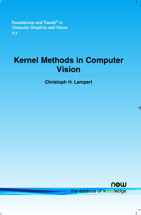Kernel Methods in Computer Vision
By Christoph H. Lampert, Max Planck Institute for Biological Cybernetics, Germany, chl@tuebingen.mpg.de
Abstract
Over the last years, kernel methods have established themselves as powerful tools for computer vision researchers as well as for practitioners. In this tutorial, we give an introduction to kernel methods in computer vision from a geometric perspective, introducing not only the ubiquitous support vector machines, but also less known techniques for regression, dimensionality reduction, outlier detection, and clustering. Additionally, we give an outlook on very recent, non-classical techniques for the prediction of structure data, for the estimation of statistical dependency, and for learning the kernel function itself. All methods are illustrated with examples of successful application from the recent computer vision research literature.
Kernel Methods in Computer Vision
Few developments have influenced the field of computer vision in the last decade more than the introduction of statistical machine learning techniques. Particularly kernel-based classifiers, such as the support vector machine, have become indispensable tools, providing a unified framework for solving a wide range of image-related prediction tasks, including face recognition, object detection and action classification.
By emphasizing the geometric intuition that all kernel methods rely on, Kernel Methods in Computer Vision provides an introduction to kernel-based machine learning techniques accessible to a wide audience including students, researchers and practitioners alike, without sacrificing mathematical correctness. It covers not only support vector machines but also less known techniques for kernel-based regression, outlier detection, clustering and dimensionality reduction. Additionally, it offers an outlook on recent developments in kernel methods that have not yet made it into the regular textbooks: structured prediction, dependency estimation and learning of the kernel function. Each topic is illustrated with examples of successful application in the computer vision literature, making Kernel Methods in Computer Vision a useful guide not only for those wanting to understand the working principles of kernel methods, but also for anyone wanting to apply them to real-life problems.
